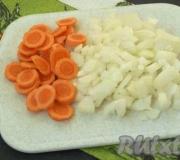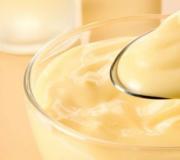An invisible door made of pistons in Minecraft. How to make doors in Minecraft from sticky pistons
Cobblestone and piston doors
Pistons and sticky pistons are used in many redstone mechanisms as they move the block directly in front of them. They are needed for harvesting crops, killing mobs, moving elevators, and creating sliding doors. Create automatic sliding doors using pistons.
1. Place four cobblestone blocks (two wide and two high) to make doors.
2. On one side of the door, one block apart, place two sticky pistons on top of each other. (The placed piston will be directed towards you by the moving half-block.)
Create two doors from four cobblestone blocks. Add two sets of two sticky pistons one block apart on each side of the door
3. Place the red torch and above it a block of cobblestone on the other side of the sticky pistons. The red stone activates the lower piston. It also energizes the cobblestone block above it, which drives the top sticky piston.

Provide energy to the pistons. The lower piston is activated by a red torch. The top one is driven by the same red torch signal passing through a block of cobblestones located above the torch
This is how you create closed door, since the energy of the red torch (which is always on) keeps the pistons in the extended position. However, you need the door to open. It is necessary to ensure that the red torch feeding the pistons is turned off. Luckily, when a signal is sent to the red torch, it shuts down! To do this, use pressure plates that will send a signal to the red torches through the redstone wiring. Four pressure plates (two on each side of the door) are placed two blocks away from the doors.
4. Dig two trenches two blocks deep on each side to connect the red torch to the pressure plates. Place one block near the red torch as a step. The thing is that the redstone wiring only goes up one block at a time, and to raise it you use steps created from blocks. The depth of the trench should be two blocks - the red stone works when there is a block of free space above it. (You can use a half-block instead of a block to cover the redstone, as this will allow enough space above the wiring for it to work.)
5. Once you have dug the trenches, place redstone wiring along them from one end to the other.

Dig trenches to carry redstone wiring from one end to the other
6. On both sides of the door, replace the empty blocks in front of them wooden planks or other flooring material and place pressure plates on them.

Add dirt blocks in front of the doors and place stone pressure plates on top
You will now be able to go through the doors. When you step on the pressure plates, they transmit a signal to the redstone wiring underneath, which reaches the sticky pistons and disables them. This opens doors. Once you walk through the doors, the pressure plates will disengage and the doors will slam shut. Trenches with wiring can be closed with any building blocks. Remember that you must leave a block of empty space above each block that has redstone wiring on it. If the wiring goes up one side of a block, there should also be a block of empty space above that block.

The picture shows a completed sliding door, the mechanism of which is completely hidden
This text is an introductory fragment.
From the book Getting Real (in Russian) [read] by 37signalsOpen Doors Release your data to the world via RSS, API, etc. Don't try to lock your customers out. Let them get the information they own when and how they want. To do this, you will have to abandon the idea of sealing the data. Release them. Give people access to
From the book ArCon. Interior design and architectural modeling for everyone author Kidruk Maxim IvanovichDoors The next object we will look at is a door. Settings for this element are called up using the Options? menu command. Doors. In this case, as for walls, a window will be called up with the settings of the object whose creation command is active in
From the book ArchiCAD 11 author Dneprov Alexander GSetting the door parameters If you click on the Settings Dialog button, the window for setting the default door parameters will open on the screen (Fig. 5.5). Rice. 5.5. Door Settings Window A quick glance at the variety of controls can be intimidating at first, but try it
From the ArchiCAD book. Let's start! author Orlov Andrey AlexandrovichSetting door parameters Pressing the button will open the Door Default Settings window (Fig. 6.5). Don’t be intimidated by the abundance of parameters. Their a large number of speaks of the possibility of making almost any fantasy come true. Let's look at the setup
From the book 3ds Max 2008 for interior design author Semak RitaDoors To build doors, activate the Geometry category on the Create tab of the command panel and in the drop-down list of subcategories (where it says Standard Primitives) select the Doors object group. In the Object Type rollout
From the book UNIX: Process Communication author Stephens William RichardCHAPTER 15 Doors
From the book Linux through the eyes of a hacker author Flenov Mikhail Evgenievich12.2. Closing SUID and SGID Doors As an administrator or security professional, you need to know your system inside and out. We have already said that one of the problems can be the SUID or SGID bit. You should clear all these bits from programs you don't use. But how to find them? For this
From the book Digital magazine "Computerra" No. 212 author Computerra MagazineReinventing the door: impractical, but impressive Nikolay Maslukhin Published February 11, 2014 Austrian designer Klemens Torggler created the concept of the Evolution Door, which has a fundamentally different way of opening. Honestly speaking, when
Ehh, hello everyone, Mr_Kriper here! And today I will show you a guide on how to make a door from pistons. And there’s no need to make a fuss in the comments because everyone knows this! Those who don't know
Guide:
Sorry there's no music (
By the way, there will be new videos soon so wait)
This guide was created for lovers of mechanisms. Here I will talk about how to make a hidden door in a wall in Minecraft: Pocket Edition.
In this guide I will teach you how to build hidden doors in the wall. In the end we will get this:
So what we need:
- 4 stone pressure plates
- 4 sticky pistons
- Redstone
- 6 repeaters
- 2 red torches
- Solid blocks
Repeaters are needed here so that as soon as you step off the pressure plates, the doors close with a delay. If desired, the delay can be increased.
Now we connect the redstone under the passage with the pressure plates on the other side of the door:
The disadvantage of this mechanism is its big sizes. I think a similar guide with a more compact version will be released soon!
Cobblestone and piston doors
Pistons and sticky pistons are used in many redstone mechanisms as they move the block directly in front of them. They are needed for harvesting crops, killing mobs, moving elevators, and creating sliding doors. Create automatic sliding doors using pistons.
1. Place four cobblestone blocks (two wide and two high) to make doors.
2. On one side of the door, one block apart, place two sticky pistons on top of each other. (The placed piston will be directed towards you by the moving half-block.)

Create two doors from four cobblestone blocks. Add two sets of two sticky pistons one block apart on each side of the door
3. Place the red torch and above it a block of cobblestone on the other side of the sticky pistons. The red stone activates the lower piston. It also energizes the cobblestone block above it, which drives the top sticky piston.

Provide energy to the pistons. The lower piston is activated by a red torch. The top one is driven by the same red torch signal passing through a block of cobblestones located above the torch
This will create a closed door as the energy from the red torch (which is always on) keeps the pistons in the extended position. However, you need the door to open. It is necessary to ensure that the red torch feeding the pistons is turned off. Luckily, when a signal is sent to the red torch, it shuts down! To do this, use pressure plates that will send a signal to the red torches through the redstone wiring. Four pressure plates (two on each side of the door) are placed two blocks away from the doors.
4. Dig two trenches two blocks deep on each side to connect the red torch to the pressure plates. Place one block near the red torch as a step. The thing is that the redstone wiring only goes up one block at a time, and to raise it you use steps created from blocks. The depth of the trench should be two blocks - the red stone works when there is a block of free space above it. (You can use a half-block instead of a block to cover the redstone, as this will allow enough space above the wiring for it to work.)
5. Once you have dug the trenches, place redstone wiring along them from one end to the other.

Dig trenches to carry redstone wiring from one end to the other
6. On both sides of the door, replace the empty blocks in front of them with wood planks or other flooring material and place pressure plates on them.

Add dirt blocks in front of the doors and place stone pressure plates on top
You will now be able to go through the doors. When you step on the pressure plates, they transmit a signal to the redstone wiring underneath, which reaches the sticky pistons and disables them. This opens doors. Once you walk through the doors, the pressure plates will disengage and the doors will slam shut. Trenches with wiring can be covered with any building blocks. Remember that you must leave a block of empty space above each block that has redstone wiring on it. If the wiring goes up one side of a block, there should also be a block of empty space above that block.

The picture shows a completed sliding door, the mechanism of which is completely hidden
The piston door in minecraft is very convenient device, it will help you prevent unauthorized entry into your home or another building by uninvited guests, or build a secret door to some room.
To build a full-fledged piston door you will need quite a lot of resources
, namely:4 sticky pistons, the pistons must be sticky, otherwise your door will only work once to close. Sticky pistons are made from regular pistons by coating them with slime, which in turn is obtained from small slugs.
A regular piston is made from 4 units of cobblestone, three planks of any type of wood, one iron ingot and one unit of red dust. After creating the piston, apply mucus to it and it becomes sticky, do this 4 times.
Red dust, which is also necessary to create pistons, is obtained by splitting red ore with an iron pickaxe, approximately 4-5 units of dust for each block of red ore. In addition to its conductive function, red dust will be used for crafting red torch and then repeaters necessary for the full functioning of piston doors. All we need is 4 red repeaters, they are created according to the following recipe.

To begin with, red torches are crafted, two for each repeater, for each torch 1 stick and 1 unit of red dust. For each repeater you will have to extract three units of stone and an additional unit of red dust. All red repeaters are ready. Now that we have all the ingredients, let's move on to building and assembling the piston door mechanism.
Let's do piston door

We place the sticky pistons at a distance of 4 blocks “facing” each other, and place stone blocks close to them (as shown in picture 1). Between the mechanisms we dig a hole 2x2x5 (depth, width, length). Additionally, we dig a ditch from the inside of the door next to the mechanism (picture 2).

Next to the pistons, we place one stone block in the ditch. We place red torches next to these blocks and remove the dust as indicated in picture 3.

In front of the doors and behind them, at a distance of 1 block, we install a pair of pressure plates and bring red dust to them, after which we carefully cover the entire lower part of the structure with some kind of material.

For safety, we install red repeaters with maximum delay in places, as seen in picture 4.
Now, when you press any of the pressure plates, the doors will open, and without crushing you, they will close after a certain period of time. Your piston door is ready for use.
You don't have to watch a video on YouTube to understand how to make a piston door in Minecraft with or without traps. I offer you a nice gift for the Christmas tree in the form of detailed description with photo this process. Works in different versions, including 1.5.2.
Making a piston door is not difficult. With a little time you can get reliable protection from unwanted persons in a home or other building, including it will be suitable protection for a secret passage. It can be used at your discretion, so you should be smart and give free rein to your imagination.
Piston door in minecraft: instructions for creating
Construction requires 4 sticky pistons to ensure the structure operates properly.
How to make a sticky piston in minecraft?
The sticky piston in minecraft is made using standard pistons on which slime is applied. Slime must be obtained from a small slug. 
The standard solution involves the use of 4 cobblestones. You also need to take 3 boards (any wood), 1 iron ingot and 1 red dust. When it is ready, mucus is applied to it. Repeat the procedure 4 times.
Red dust in minecraft
Without it, you won’t be able to make pistons, so you need to get it. It appears when red ore splits. In this case, an iron pickaxe is used. The approximate yield is 4 – 5 dust for one red ore. This item Suitable for both conducting role and making red torch crafting and repeater crafting. In total we make 4 red type repeaters.
Red Repeater: Recipe
First of all, we craft torches, of which you need at least 2 pieces. In addition, one torch takes one stick and the same amount of dust. We extract 3 stones for 1 repeater and also add red dust.
How to make a piston door in Minecraft?
To begin, install the pistons at a distance of 4 blocks. The front parts should face each other. We place a block of stone next to them. We make a hole 2 deep, 2 wide and 5 long. 
On inside another ditch is being made. 
Near the piston, 1 stone block should be placed directly into the ditch for each part of the structure. After this, we will install red torches near the placed blocks, after which we will remove the red dust. 
It is recommended to place several pressure plates near the structure and behind it with a distance of one block. After this, dust is applied to the slabs, and the bottom of the assembly should be covered with any of the available materials. 
For safety reasons, the highest possible delay is selected for repeaters. We press on pressure plate and open the door, and it closes after a given time.




